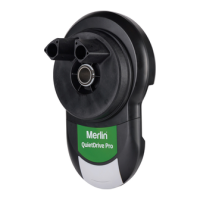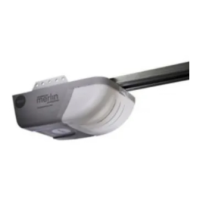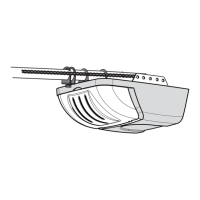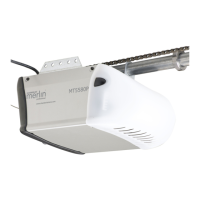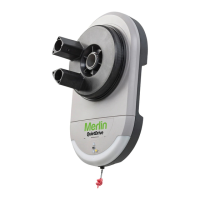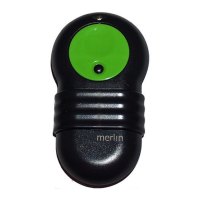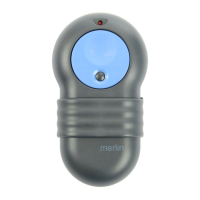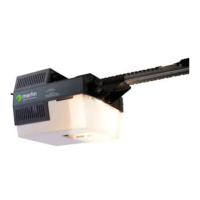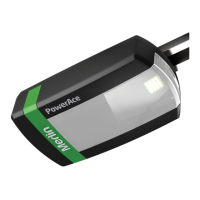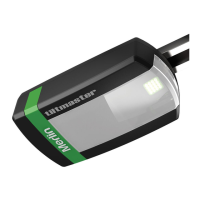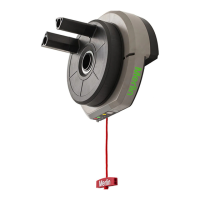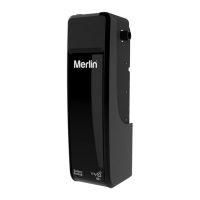The Merlin QuietDrive Pro MR655EVO is a garage roller door opener designed for residential use, offering safe and reliable operation when installed and maintained according to the provided instructions.
Function Description:
The QuietDrive Pro MR655EVO is a garage roller door opener that automates the opening and closing of spring-balanced residential rolling garage doors. It can be activated via its control panel, remote control transmitters, or an optional wireless entry keypad. The opener is designed to stop the door if an obstruction is encountered during closing or opening, and it can reverse direction if the door has been stopped in a partially open or closed position. It also features an optional "Ventilation Mode" for partial opening, allowing for pedestrian or pet access and ventilation. The opener is factory-configured for right-hand installation but can be adjusted for left-hand installations during the limit setting process.
Important Technical Specifications:
- Input Voltage: 220-240 VAC, 50-60 Hz, 110 W
- Rated Load: 32 Nm
- Max. Pull Force: 500 N @ 300 mm
- Max. Door Weight: 100 kg
- Max Lift under Spring Tension: 20 kg
- Max. Door Area: 16.5 m²
- Standby Power: <1 watt (in low standby mode)
- Drive: DC gear motor permanent lubrication
- Max. Drum Rotations: 4.5
- Memory Registers: 64
- Operating Frequency: 433.30/433.92/434.54 MHz
- Operating Temperature: -25°C to 55°C
- Maximum door height: 4.5 m
- Maximum curtain area: 16.5 m²
- Maximum door mass: 100 kg
- Door axle diameter: Must not exceed 35 mm.
- Safety Reverse System: The door MUST reverse on contact with a 40 mm obstacle placed on the floor.
- Obstruction Detection Beams (Optional): Required if the closing force at the edge of the door exceeds 400 N (40 kgf). These beams use an infra-red beam to detect obstructions, causing the door to stop and open.
Usage Features:
- Control Panel: Includes UP, DOWN, P (Program), and S (Save/Delete Remote Controls) buttons, along with LEDs for program and diagnostic indicators. A "Control Button" allows activation (Open - Stop - Close) when remotes are unavailable.
- Remote Control Transmitters: Two E960M Premium transmitters are included. Additional transmitters (E950M, E940M, E943M, E945M) can be programmed.
- Wireless Wall Button: An E138M wireless wall button is included and pre-programmed.
- Manual Release: A red manual release cord allows for manual operation during power outages or emergencies. The handle should be no higher than 1.8 meters from the floor.
- Courtesy Light: Turns on during operation and automatically turns off after 3 minutes. It also flashes at half strength during programming sequences.
- Audible Beep (Optional): The opener is factory-set for an audible "BEEP" on button presses, which can be turned ON/OFF.
- Ventilation Mode (Partial Opening Feature): Allows for a pre-set second stop position for ventilation, pedestrian, or pet access. This feature can be programmed to a remote control button.
- Standby Mode: Factory-set for low standby mode (<1 watt). Normal standby mode can be activated if external accessory power is required.
- Wireless Programming: New remote controls can be programmed to the opener using the "S" button. All remote control codes can also be erased.
- Warning Labels: Warning labels for entrapment risk and general warnings must be installed in prominent places, adjacent to wall controls and manual release mechanisms, and out of reach of children.
- Extension Poles (Optional): Can be attached to the drive legs for additional support, requiring a reinforcing brace.
Maintenance Features:
- Minimal Maintenance: The opener requires minimal maintenance and no additional lubrication.
- Monthly Checks:
- Repeat the safety reverse test (section 15) and make any necessary adjustments.
- Manually operate the door to check for unbalance or binding. Call for professional garage door service if issues are found.
- Check that the door opens and closes fully. Set limits and/or force if necessary.
- Limit and Force Settings: These settings must be checked and properly set during installation and re-adjusted if weather conditions cause minor changes in door operation.
- Transmitter Battery Replacement: If the transmission range decreases, the battery (CR2032 or equivalent) in the remote control should be replaced. Instructions for replacement are provided, emphasizing safety precautions for handling batteries.
- Door Maintenance: The garage door itself must be spring-balanced, operable by hand with no more than 20 kg of lifting weight, and professionally maintained and serviced at least during the third year of the warranty period.
- Troubleshooting Guide: A comprehensive diagnostic chart is provided to help identify and resolve common issues based on LED indicators and symptoms.
